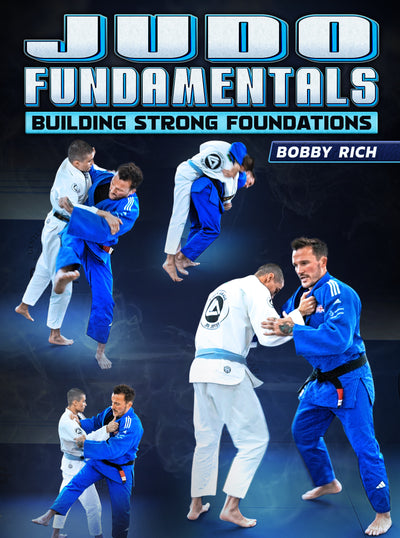No Gi Ouchi Gari With Satoshi Ishii
Ouchi Gari (meaning Big Inner Reap in English) is a staple of the Judo takedowns, and is included in the original forty throws developed and employed by Judo founder Jigoro Kano. It belongs in the Dai Ikkyo (first group) of traditional throws of Kodokan Judo, and as such is amongst the first throws a Judoka will learn. When Judo was founded in Japan it became so popular precisely because the Kodokan Judo was so incredibly dominant in the throwing game.
The standard Ouchi Gari is taught using the gi and is executed from the standard sleeve and lapel grip that is the bedrock of much Judo tachi waza (standing technique). The sleeve grip is used to control either the wrist or elbow and the lapel grip is used to initiate the pushing motion into the opponent, often into the meeting point between the shoulder and chest.
In a no gi situation however we don’t have the same appendages to grip as with the kimono, so what do we do? Fortunately we have Judo Olympic Gold medalist, All Japan Judo Champion and MMA fighter Satoshi Ishii to talk us through his Ouch Gari game in a no gi context.
Satoshi notes that a lot of people in the no gi context reach around their opponents back and at the same time trap the arm with the arm that would ordinarily be used to grip the lapel of the kimono. Satoshi doesn’t like that way of gripping for Ouchi Gari and so instead uses an underhook grip with the arm that would usually grip the lapel. The other hand that would typically grip the sleeve is now gripping directly onto the elbow, or even better onto the wrist if it is available.
Want to add some WORLD CLASS Judo technique to your No-Gi game? Click Learn More!
From here the kuzushi (breaking of balance) that is used is pulling our opponent forward so that their weight is on the same leg as the side that we have the underhook on. A simple pull forward that forces our opponent to step with this leg is all that’s needed to shift their weight in this manner.
Once this part of kuzushi has been achieved the footwork for Ouch Gari now comes into play, with our back foot pulling in behind our lead foot and our lead foot then being able to drive forward behind our opponents leg that they now have their weight on.
A mistake Satoshi sees here is that people lift their sweeping leg upwards, which means your throwing attempt can be easily countered by your opponent. Not good! Instead your sweeping leg stays down and your foot floats across the surface of the mat so that your legs are opening but your foot is kept as low as possible. The key to success with this sweep is timing and capitalizing on your kuzushi work by catching your opponent off balance.
If we pay close attention to Satoshi’s sweeping leg in the video we see that it’s not a linear sweeping motion, but instead a circular sweeping motion. This circular motion gives our opponent an indirect force to try to move against instead of the more straightforward linear sweep of a straight movement backwards with the foot, and as such is harder to defend against. Another key detail is paying attention to the direction our opponents toes are pointed and sweeping in this direction.
As with all throws or sweeps the head plays a crucial role in the direction of the force acted on to our opponent. Satoshi advises us to imagine our opponent is diagonal to where our actual opponent is and to drive towards this opponent, thereby pushing our force to off-balance our opponent, while at the same time sweeping their weight-bearing leg away from them with the reaping motion of our foot.
Satoshi notes that following the Ouchi Gari we don’t hang onto our opponent but maintain positive control and positive follow-up. As we are using Ouchi Gari we will be landing in between our opponents legs so if we aren’t positive in our follow through there is a risk we will do all that work in the standing game only to land in our opponents closed guard and be vulnerable to their attacks from closed guard.
Instead when landing after completing Ouchi Gari Satoshi quickly moves to an over-under guard pass position, or creates positive control of his opponents arms at the biceps in order that he can set up his top game on the ground in a positive and attacking manner.

If you want to unlock your standing game then who better to learn from than Judo Olympic Gold medalist, All Japan Judo Champion and MMA fighter Satoshi Ishii?Check out Satoshi’s No GI Judo for Grapplers here!



